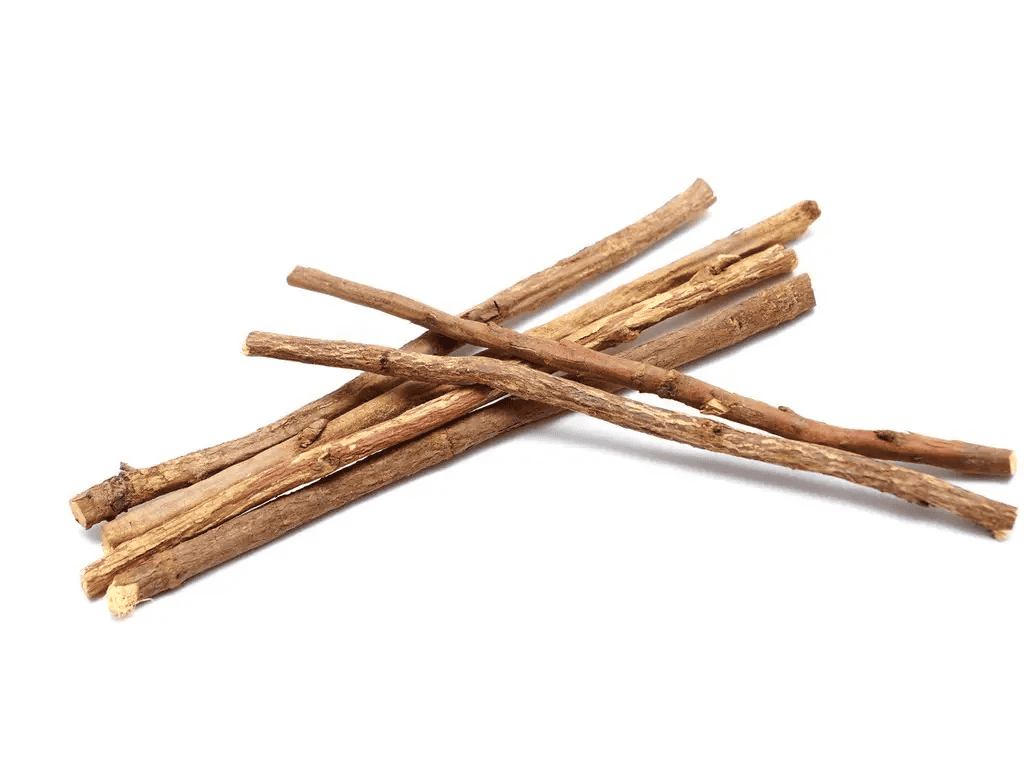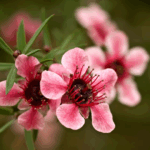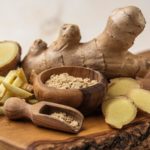
Megan Amrein
(BNatMed)
For many of us, licorice today is known mostly because of its use in the food industry, especially in production of confectionery.
However, licorice in its pure and unprocessed form also has beneficial health properties and can assist us with oral and gastrointestinal health.
Introduction
Licorice is native to Southeast, Central and Southwest Europe.
The benefits of licorice have long been known and utilised for thousands of years by various cultures. As an example, Egyptians used licorice as a pharmaceutical and copious supplies were said to be found in King Tut’s tomb.
Julius Caesar and Alexander the Great also used licorice, and often chewed on it to help keep their spirits up and body healthy.
Other names
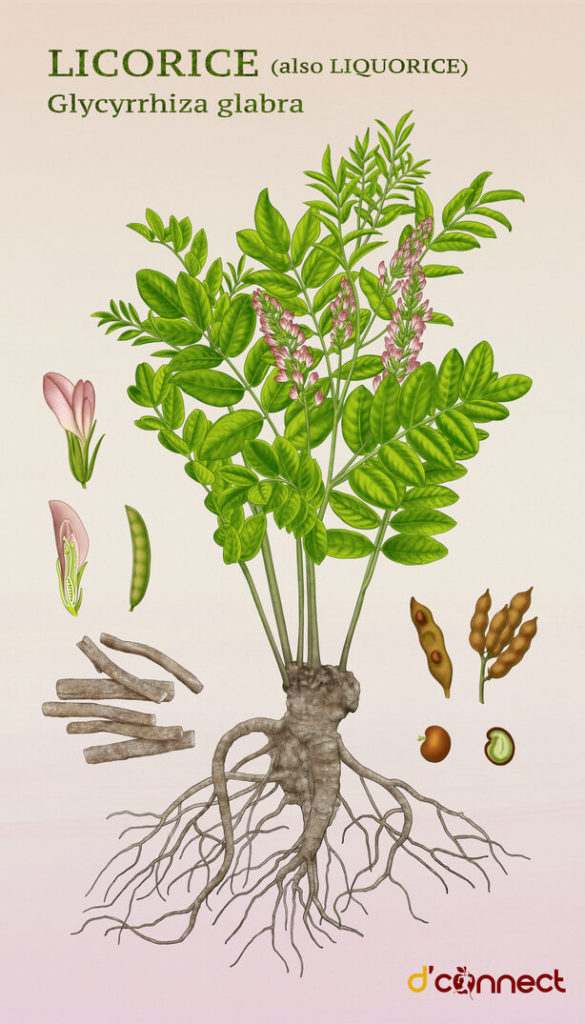
Glycyrrhiza glabra stems from the Greek language glykos = sweet and rhiza = root.
Botanical name (latin binomial): Glycyrrhiza glabra.
Pharmaceutical name: Radix Glycyrrhizae.[1]
Ancient names: Glykyrizza (Greek), Liquirita (Latin).
Other names: Bois doux (French), Shag.es sus (Arabic), ‘Erq sus (Arabic), Gan Cao (mandarin), Gam Chou (cantonese), Kanzo (Japanese).
Characteristics
Licorice is a perennial that dies down in winter. It is a hairless, robust plant with leaves that are matt green and sticky underneath.[2]
It usually grows in clay or sandy soil near a stream or a river for the plant to flourish.[3]
Flowers are abundant in summer and are a bluish/violet colour, about 1cm in size. The odour of the licorice plant is faint, however very characteristic and has a sweet and mildly aromatic taste.[2]
Licorice root is used for medicinal purposes
Key constituents:
- Triterpenes
- Flavonoids
- Polysaccharides
- Glycyrrhizin and Glabridin
Use
Licorice has been used for centuries and continues to be a popular herb in herbal medicine and natural therapies.
Traditional Use
First records mention licorice being in use for over 4,000 years in all major ancient cultures.[2] Traditionally, licorice has been a herb of choice for ailments and diseases such as:
- Sore throats
- Flatulence
- Fever
- Asthma
- Cough
- Stomach ulcers
- Heartburn
- Rheumatism
- Jaundice
This versatile herb was also reported for being used as an insecticide, memory stimulant, antibiotic, anti-ulcer, and anti-inflammatory actions.[3,4]
Licorice has also been used in folk medicine as a laxative, galactagogue (stimulates milk production), anti-asthmatic, and antiviral agent.[5] It also showed benefits for peptic ulcers, pharyngitis, malaria, insomnia, abdominal pain, and infections.[6]
Medicinal Use
Licorice has a strong affinity for the digestive system and has been seen to support several ulcerative conditions. The anti-inflammatory actions of licorice are beneficial in treating;
- Oral ulcers
- Gastric ulcers
- Ulcerative colitis[4]
Licorice has also been shown to repair the microscopic damage that is seen in ulcerative conditions.[4]
Licorice has a range of pharmacological actions, including;
- Estrogenic
- Anti-inflammatory
- Anti-allergic
- Antibacterial and antiviral
- Antihepatotoxic
- Anticonvulsive
- Choleretic
- Anticancer
- Expectorant
- Antitussive[6]
Bioactive ingredients in licorice, glycyrrhizin and glabridin show benefits in treating oral diseases such as plaque, gingivitis, dental caries, candidiasis, and periodontitis.[5]
This offers significant benefits over chlorhexidine (an ingredient in mouthwash that is also used as a disinfectant and antiseptic for skin disinfection before surgery and to sterilize surgical instruments).
Chlorhexidine side effects are erosion of the oral mucosa and staining of the teeth and gums.[5]
Nutritional facts
Licorice can be enjoyed as a tea along with medicinal herbal preparations. Licorice contains
- Vitamin E
- Vitamin B complex (B1, B2, B3, B5, B6, B7, B9 and B12)
Minerals found in licorice include;
- Phosphorus
- Iodine
- Chromium
- Manganese
- Zinc
Health benefits
Anti-inflammatory and antioxidant actions of licorice
Licorice possesses anti-inflammatory properties, and is especially observed to be beneficial in intestinal disorders.
Due to its antioxidant actions combined with anti-tumour effects, it is a suitable herb for those with inflammatory bowel conditions.[7,8,9]
As an example, a study focusing on licorice’s anti-inflammatory actions researched licorice flavonoids used at low, medium and high doses on paw oedema in mice, in comparison with aspirin.[10]
Shown below: the medium and high dose of licorice flavonoids offer similar if not better results than aspirin.

Due to the high antioxidant levels in licorice it can also be beneficial in topical skin applications due to its effects of counteracting oxidative stress damage.[9]
Antiviral and antimicrobial actions of licorice
Licorice has close to 300 flavonoids and 20 triterpenoids.[11] Many studies conducted on licorice have shown that two triterpenoids show antiviral activity. Inhibition of influenza virus has also been demonstrated with licorice.[12]
Antimicrobial actions have shown promising strength in eradicating Staphylococcus aureus and Candida albicans.[11] Due to increasing antibiotic resistance, in particular with methicillin-resistant S. aureus (MRSA) alternative therapies have a strong need.[11]
Of particular interest in the viral world is SARS-CoV-2 (coronavirus) which has an 80% genome sequence identity to SARS-CoV-1. Glycyrrhizin, an active constituent in licorice has shown positive findings with its actions on SARS-CoV through inhibition of replication.[13]
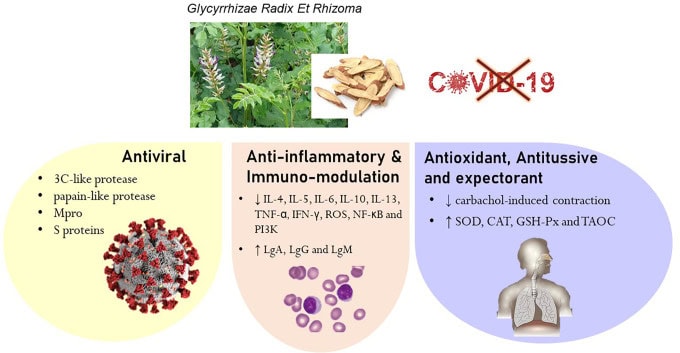
Memory-enhancing actions of licorice
The process is initiated by a Food additive petition. It goes through scientific data review, where only animal testing data are required.
Licorice supports healthy memory
Given the strong anti-inflammatory and antioxidant actions of licorice they have proven beneficial in supporting and enhancing memory.
RELATED — Ginkgo (Ginkgo Biloba)
In studies with rodents, a significant improvement in memory was observed alongside repairing the effects of amnesia related to diazepam use.[14]
In another study on mice significant cognitive improvement was observed with recognition memory and learning; this also has been attributed to anti-inflammatory actions helping in reducing neuroinflammation.[15]
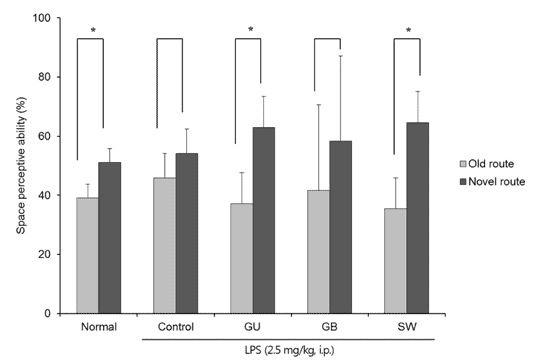
Normal - 0.9% injection + oral administration of water; Control - LPS injection + oral administration of water;
GU - LPS injection + oral administration G. uralensis (150 mg/kg/day);
GB - LPS injection + oral administration G. glabra (150 mg/kg/day);
SW - LPS injection + oral administration SW (150 mg/kg/day).
Due to the neuroprotective effects of licorice, it is said to be supportive in post-ischemic brain stroke, which causes irreversible brain damage.
Current recovery therapy focuses on recovery of the blood supply. One of the main constituents, glabridin modulates the middle cerebral artery occlusion, helping to support blood flow.[16]
RELATED — Introduction to: Brain Health
Anti-ulcer properties of licorice
Due to the demulcent actions that licorice possesses, it is particularly soothing for the gastrointestinal tract. Gastric ulcers have a global incidence of 10%.
Gastric ulcers are a superficial disease of the gastric mucosa, often caused by excessive tobacco, alcohol, non-steroidal anti-inflammatory drugs, and stress (psychological).
Licorice promotes the production of short-chain fatty acids which promote anti-inflammatory, immunomodulatory, and anticancer actions.[17]
Licorice is also known to increase gastric secretion, regulate gut microbiota, promote mucosa regeneration, and restore epithelial barrier functions.[8]

Licorice stimulated epidermal growth factor (EGF) receptor pathway promoting mucosa cell regeneration; regulating cells that produce mucus in the gastrointestinal tract (epithelial cells).
Therapeutic dosage
Licorice can be used in a range of preparations such as:
- Tincture
- Ointment
- Infusion (tea)
- Essential oils
Therapeutic dosing of licorice root for an adult is considered:
- Decoction – 1-4g, three times a day
- Fluid extraction (20%) – 2-5ml, three times a day[1]
- Powdered root – 1-2g, three times a day[6]
Safety concerns
When licorice is taken at the recommended dose, duration and not used in contraindicated conditions, it is considered to be a safe herb. Adverse effects are seldom seen in doses below 100mg/day.
However, adverse effects can be quite common when levels 400mg/day are used.[6]
Allergic reactions can occur in those with known allergies to plants in the asteraceae family and should be cautious.
Licorice is contraindicated in:
- High blood pressure (hypertension)
- Pregnancy
- Hypokalaemia
- Cirrhosis
- Heart failure, heart disease
- Hormone sensitive cancers
- Fluid retention
- High blood pressure
- Diabetes
- Kidney disease
- Erectile dysfunction[18]
High doses of licorice should not be used for longer than 6 weeks.
Licorice is known to increase blood pressure which is why it needs to be avoided in those with hypertension and/or renal complications.[6]
Licorice-induced hypertension is exacerbated in those with high salt intakes.[1]
RELATED — Sodium (for nerve health, and fluid and minerals equilibrium)
There are reports of a reduction in men’s testosterone with doses of 7g a day.[1,6]
Possible interactions with medications
As with all herbs, there are some areas of safety to acknowledge when considering taking licorice.
If you are on medication/s it is advised to check with your natural health practitioner before taking herbal supplementation to ensure safety and suitability.
Licorice has been shown to inhibit P450 3A4 which is a major drug metabolising enzyme, therefore interactions with the actions of drugs may occur with a range of medications.[6]
Licorice is not to be taken with:
- Antihypertensive medication
- Diuretic medication
- Insulin or oral hypoglycemic medications
- Laxatives
- Corticosteroid, glucocorticoid and mineralocorticoid medications
- ACE inhibitors
- Warfarin
- Oral contraceptive
Spironolactone (anti-hypertensive medication), especially in those with polycystic ovarian syndrome (PCOS) should be avoided with licorice. This combination can inhibit the hypotensive actions and enhance the antiandrogen actions of spironolactone.[6]
Taking licorice and spironolactone can lead to abnormal uterine bleeding (metrorrhagia).[3]
The use of diuretics and laxatives with licorice is not advised due to causing a further reduction in already low potassium. This can then lead to hypertension, oedema, and kidney failure.[1,6]
RELATED — Potassium (for blood pressure, heart rhythm and pH balance)
Those using insulin or oral hypoglycemic medications need to ensure blood sugar levels are monitored closely if licorice is to be used.
Possible interactions with herbs and supplements
Licorice is generally considered a safe herb to use with other herbs and supplements.
Caution should be advised when using herbs that also have laxative effects such as:
- aloe vera
- senna
- psyllium
- slippery elm
as these actions may be potentiated if combined with licorice.
Summary

Note — feel free to share or download this illustration.
Related Questions
1. Can licorice be taken with anti-hypertensive medication?
No, licorice and anti-hypertensive medication (blood-pressure medication) cannot be taken together.
2. Who should avoid taking licorice?
Those taking pharmaceutical medication without first consulting their natural health practitioner.
Those with the following conditions should also avoid licorice:
- Heart failure, heart disease
- Hormone sensitive cancers
- Fluid retention
- High blood pressure
- Diabetes
- Kidney and/or liver disease
- Low potassium
- Erectile dysfunction
3. Should licorice be taken at a certain time of the day?
In general no, however, it depends what it is being used for.
Licorice does not have a stimulating effect so it is fine to take it in the evenings.
4. Can licorice be taken long term?
Licorice can be taken for up to 3 months.
5. Can licorice assist with menopause symptoms?
Yes, in particular licorice can help support hot flashes due to its estrogenic actions.
RELATED — 5 Natural Remedies for Menopause
If you are looking for similar articles, you can find them in our Herbs.
Megan is a qualified Naturopath and Medical Herbalist. She completed her degree in Naturopathic and Herbal Medicine in 2021.
References
(1) Holmes, P. (2007). The energetics of western herbs: A materia medica integrating western & Chinese herbal therapeutics: Vol.1 (Rev. ed.) (4th ed.). Boulder, CO: Snow Lotus Press.
(2) Fisher, C. (2009). Materia medica of western herbs. Vitex Medica.
(3) Bahita, G, E., Beshbishy, A, M., El-Mleeh, A., Abdel-Daim, M., & Devkota, H, P. (2020). Traditional uses, bioactive chemical constituents, and pharmacological and toxicological activities of Glycyrrhiza glabra L. (Fabaceae). Biomolecules, 10(3), 352. https://www.ncbi.nlm.nih.gov/pmc/articles/PMC7175350/
(4) Yang, R., Yuan, B., Ma, Y., Zhou, S., & Liu, Y. (2017). The anti-inflammatory activity of licorice, a widely used Chinese herb. Pharmaceutical Biology, 55(1), 5-18. https://www.ncbi.nlm.nih.gov/pmc/articles/PMC7012004/#CIT0026
(5) Sakshi, S., Sogi., G. M., Saini, V., Chakraborty, T., & Sudan, J. (2022). Effect of liquorice (root extract) mouth rinse on dental plaque and gingivitis – a randomised controlled clinical trial. Journal of Indian Society of Periodontology, 26(1), 51-57. https://www.ncbi.nlm.nih.gov/pmc/articles/PMC8796775/
(6) Murray, M.T. (2013). Glycyrrhiza glabra (Licorice). In J. E. Pizzorno & M. T. Murray, Textbook of natural medicine (4th ed., pp. 804-810). St Louis, MO: Elsevier.
(7) Leite, C. dos S., Bonafé, G. A., Carvalho Santos, J., Martinez, C. A. R., Ortega, M. M., & Ribeiro, M. L. (2022). The Anti-Inflammatory Properties of Licorice (Glycyrrhiza glabra)-Derived Compounds in Intestinal Disorders. International Journal of Molecular Sciences, 23(8), 4121. https://doi.org/10.3390/ijms23084121
(8) Lohar., A. V., Wankhade., A. M., Mohd., F., Jagtap, A. (2020). A review on glycyrrhiza glabra linn (liquorice) – an excellent medicinal plant. European Journal of Biomedical and Pharmaceutical Sciences, 7(7), 330-334. Retrieved from https://www.ejbps.com/
(9) Pastorino, G., Cornara, L., Soares, S., Rodrigues, F., & Oliveira, M. B. P. P. (2018). Licorice (Glycyrrhiza glabra): A phytochemical and pharmacological review. Phytotherapy Research: PTR, 32(12),
(10) Yu, X., Bao, Y., Meng, X., Wang, S., Li, T., Chang, X., Xu, W., Yang, G., & Bo, T. (2019). Multi‑pathway integrated adjustment mechanism of licorice flavonoids presenting anti‑inflammatory activity. Oncology Letters. https://doi.org/10.3892/ol.2019.10793
(11) Wang, L., Yang, R., Yuan, B., Liu, Y., & Liu, C. (2015). The antiviral and antimicrobial activities of licorice, a widely-used Chinese herb. Acta Pharmaceutica Sinica B, 5(4), 310–315. https://doi.org/10.1016/j.apsb.2015.05.005
(12) Huan, C., Xu, Y., Zhang, W., Guo, T., Pan, H., & Gao, S. (2021). Research Progress on the Antiviral Activity of Glycyrrhizin and its Derivatives in Licorice. Frontiers in Pharmacology, 12. https://doi.org/10.3389/fphar.2021.680674
(13) Ng, S. L., Khaw, K.-Y., Ong, Y. S., Goh, H. P., Kifli, N., Teh, S. P., Ming, L. C., Kotra, V., & Goh, B. H. (2021). Licorice: A Potential Herb in Overcoming SARS-CoV-2 Infections. Journal of Evidence-Based Integrative Medicine, 26, 2515690X2199666. https://doi.org/10.1177/2515690×21996662
(14) Chakravarthi, K., & Avadhani, R. (2013). Beneficial effect of aqueous root extract of Glycyrrhiza glabra on learning and memory using different behavioral models: An experimental study. Journal of Natural Science, Biology and Medicine, 4(2), 420.
(15) Cho, M. J., Kim, J. H., Park, C. H., Lee, A. Y., Shin, Y. S., Lee, J. H., Park, C. G., & Cho, E. J. (2018). Comparison of the effect of three licorice varieties on cognitive improvement via an amelioration of neuroinflammation in lipopolysaccharide-induced mice. Nutrition Research and Practice, 12(3), 191. https://doi.org/10.4162/nrp.2018.12.3.191
(16) Parvin Zulfugarova, Tayebeh Zivari-Ghader, Sevinj Maharramova, Ahmadian, E., Eftekhari, A., Rovshan Khalilov, Vugar Ali Turksoy, Rosic, G., & Dragica Selakovic. (2023). A mechanistic review of pharmacological activities of homeopathic medicine licorice against neural diseases. Frontiers in Neuroscience, 17. https://doi.org/10.3389/fnins.2023.1148258
(17) Xiong, R.-G., Zhou, D.-D., Wu, S.-X., Huang, S.-Y., Saimaiti, A., Yang, Z.-J., Shang, A., Zhao, C.-N., Gan, R.-Y., & Li, H.-B. (2022). Health Benefits and Side Effects of Short-Chain Fatty Acids. Foods, 11(18), 2863. https://doi.org/10.3390/foods11182863
(18) Licorice Information | Mount Sinai – New York. (n.d.). Mount Sinai Health System. https://www.mountsinai.org/health-library/herb/licorice

